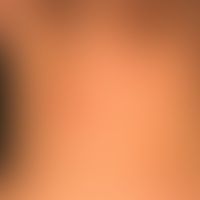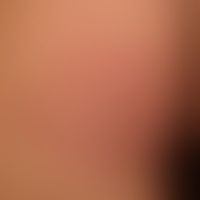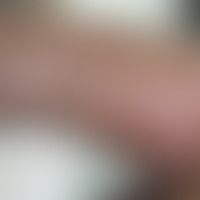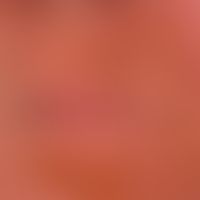Image diagnoses for "red"
901 results with 4543 images
Results forred

Anticonvulsant hypersensitivity syndrome T88.7

Porphyria cutanea tarda E80.1
Porphyria cutanea tarda: close-up. older scars marked by stars. vertical arrows: encrusted erosions after traumta; vertical arrows: bulging (subepithelial - the entire epidermis forms the firm bladder roof) fresh areactive blisters (the blisters appear as if from nowhere. no signs of inflammation!)

Melanoma cutaneous C43.-
Amelanotic acrolentiginous malignant melanoma: slowly growing nodule known for several years; increasing nail destruction in the last six months, also weeping and bleeding, sometimes slight pain; encircled and marked with an arrow, deep-seated pigment remains, which suggest the diagnosis "malignant melanoma".

Tinea corporis B35.4
Tinea corporis:unusually extensive, large-area tinea corporis in known HIV infection.
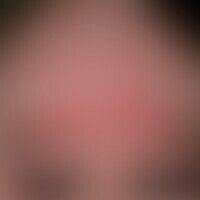
Rosacea L71.1; L71.8; L71.9;
Rosacea. stage II rosacea (rosacea papulopustulosa) Detail enlargement: Multiple, individually or grouped standing inflammatory papules, pustules and papulopustules as well as flat, red spots on the forehead and cheek area of a 62-year-old patient
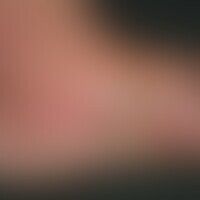
Erysipelas A46
Sharply limited redness on the left inner side of the foot with hemorrhagic blistering and honey-yellow incrustations in a 74-year-old female patient.
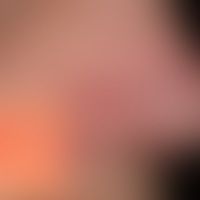
Basal cell carcinoma (overview) C44.-
Nodular or nodular basal cell carcinoma: Relatively inconspicuous, non-symptomatic, red nodule with a smooth surface (see incident light image as inlet); the bizarre (tumor) vessels of the basal cell carcinoma become visible in incident light.
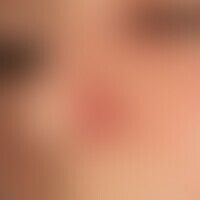
Basal cell carcinoma nodular C44.L
Basal cell carcinoma, nodular. solitary, 1.0 x 1.2 cm large, broad-based, firm, painless nodule, with a shiny, smooth parchment-like surface covered by ectatic, bizarre vessels. Note: There is no follicular structure on the surface of the nodule (compare surrounding skin of the bridge of the nose with the protruding follicles).
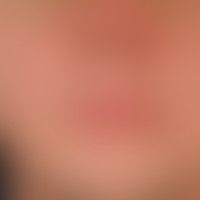
Acne papulopustulosa L70.9
Acne papulopustulosa: in acne-typical distribution, with large-pored skin, few red smooth and excoriated papules and some pustules.

Atopic dermatitis (overview) L20.-
eczema, atopic. chronic, recurrent, itchy, red spots as well as slightly raised, rough, red plaques on the forehead of an 8-month-old girl. furthermore multiple, disseminated, partly crusty scratch excoriations. fine-lamellar scaling in the region of the nose

Keratosis lichenoides chronica L85.8
Keratosis lichenoides chronica:Lichen-planus-like clinical picture with flat lichenoid plaques, on the forearm streaky excoriations due to distinct and permanent itching.

Prurigo simplex subacuta L28.2
Prurigo simplex subacuata: typical distribution pattern of the interval-like itching, scratched, inflammatory papules and plaques.

Toxic epidermal necrolysis L51.2
Toxic epidermal necrolysis. emergency hospitalization of a highly febrile (temp. 39.5 °C) 78-year-old woman with hemorrhagic, areal, epidermal necrolysis in the area of the left arm after ingestion of vancomycin. significantly reduced general condition. it turned out that the patient had received allopurinol and ampicillin for the first time a few days before.
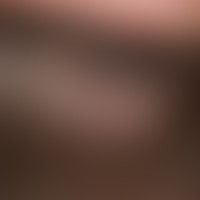
Lichen planus follicularis capillitii L66.1
Lichen planus follicularis capillitii: Increasing focal hair loss, reddish red with irregular, scarring alopecia (lack of follicular structure).

Chronic actinic dermatitis (overview) L57.1
Dermatitis chronic actinic: Severe extensive, permanently itchy eczema reaction of the entire face with intensification of the eyelid regions. improvement in the winter months. recurrence with low UV irradiation.

Exfoliation areata linguae K14.1
exfoliatio areata linguae. numerous, confluent, roundish "plaque free" areas. distinct burning sensation with spicy food or fruity drinks. characteristic for the clinical picture are the whitish swollen, raised border areas, which are clearly visible at the lateral edges of the tongue... in the middle area of the tongue normal plaque.

